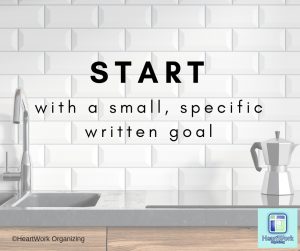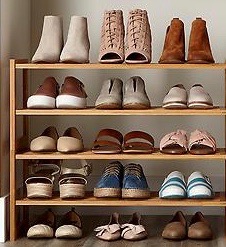The following is excerpted from the best-selling book: Organizing Your Kitchen with SORT and Succeed:
If you want to get healthy, the kitchen is a great place to start. Research shows that cluttered kitchens prompted people to eat 44% more snack food than a kitchen that was organized and decluttered.

Unless you are working with a paid professional organizer, do not start out with the goal to organize your entire kitchen. For most people, it’s just too big of a goal to accomplish in the ideal project timeframe of between fifteen minutes and four hours.
Clear the sink
Clear the countertop
Remove or re-organize magnets and notes stuck to the refrigerator door
Baking supplies
Cleaning supplies
Pantry items
Small appliances
Everyday dishes
Grill, picnic and party gear
Refrigerator (inside)
Freezer (inside)
Towels, napkins, placemats and tablecloths
Pick one of these mini-projects, or choose something that’s specific to your kitchen, and write down your goal. It can be a single bullet point. It can be on scrap paper or the back of an envelope. Just write down the one thing you are working on today, right now.
A written reminder can help you stay focused on your project and reel you back into the kitchen when you start to wander off. It’s the equivalent of having that professional organizer or good friend there beside you, tapping you on the shoulder, reminding you to stay focused on what you said you were going to do today.
After writing down your goal for this project, actually get started. You’ve already completed one-fifth of the SORT and Succeed system to organize your kitchen or anything in your home.
As an organizer it is my job to help my clients sort through belongings and ask themselves tough questions, like:
A lot of times the answers are that they have a) never used it, b) used it once, c) it was given to them and they never liked it, or d) I have 3 things that perform the same function. These answers usually mean the object needs to go. For the things my clients are struggling to let go of and think they may need “some day” I tell them to “USE IT OR LOSE IT”!
If you don’t USE IT your gonna LOSE IT (donate it). Once we agree that an item fits into the “USE IT OR LOSE IT” category we need to assess it and give it an expiration date. We physically assign a date by writing it on a post-it and slapping it on the item. Then we put that item somewhere it is easily accessible so that it has every opportunity to be used. For example, if you think you absolutely must keep your 1980s hair crimper we will put it on the bathroom counter so after 30 days if you haven’t used it, when it was right in front of you, then you never will and it goes into the donate pile.

Some things to think about when assigning an expiration date are:
Something that was very expensive gets a longer expiration date than something very cheap. Something you’ve had for 10 years and used once gets a much shorter deadline than something you’ve only had six months. Something large gets a shorter deadline than something small.
Sometimes these lines are blurred because things can fit into multiple categories. A ping-pong table takes up a lot of space but it may be worth a lot of money. This is when you need to reflect on what your individual priorities are. Do you value the space in your home over the money spent or the money you could get to sell it? Each individual has different priorities and that is okay, you need to come up with a timeline that feels right to you.
If you say that you are giving yourself 3 months to play ping pong and that date comes and goes you need to stick to your expiration date and let the item go. Accountability is key!
Everyone knows that our lungs are the major organ in our respiratory system, that our brain is central to our nervous system and that our stomach and intestines are partners in our digestive system.

How does that connect to organizing? Just look at the word: there is an ORGAN inside organizing!
Our bones — amazing organs within our skeletal system — form the structure of our bodies while they protect our internal organs. With the help of ligaments and tendons, our skeletal system allows us to move.
 Let’s look at our households like our bodies — and see ORGANizing from an interdependent, systemic perspective:
Let’s look at our households like our bodies — and see ORGANizing from an interdependent, systemic perspective:
• providing structure and support
• filtering toxins (clutter)
• creating space for nourishment
• allowing time to digest our days
• minimizing distractions
As the daughter of a D.O., the osteopathic approach always takes the whole person into consideration. Likewise, I consider the whole household when organizing.
 On that note, let’s all head into 2019, protecting our:
On that note, let’s all head into 2019, protecting our:
• organizing time like our brains
• organizing framework as we maintain our posture
• organizing schedule as routinely as brushing our teeth
• and use our ORGANizing muscles to stay healthy!
Happy New Year

In between holidays, most of us aren’t working…a great use of some of that free time is to get a little organizational housekeeping out of the way. Here are some great, easy steps you can do to start 2019 off on the right foot!
December 31 is the deadline for getting all of your donations together, whether it be financial or stuff. With the new tax laws in place, try tracking donations using It’s Deductible to easily track what has been donated. If it is stuff you want to donate don’t wait until the 31st. I have seen donation centers unable to accept items toward the very end of the year.
Do you look at your holiday cards every season and have no idea who you need to send them to?
This is the time to update your 2019 Holiday Card List! Document who you sent cards to and who you received them from. Keep a record so that you can just pull out your list next year and start addressing. You can do that on a spreadsheet or if you really want to be ahead of the game, you can make a document for your labels so that all you have to do next year is “edit” and ‘print”, easy peasy.
Do you find old gift cards all over your house? Gather your gift cards together in one place so that you can easily find them. If you have a lot, put them in an envelope and label it with the cards you have. This will help save you from letting them expire. Use them before the restaurants that you have them for go out of business (this happened to me this year). I made a reservation and the next day they closed, annoying.
Put your Christmas decorations away properly.
Give away any decorations that you haven’t used in a while. Decorating time will be more pleasant next year if you are only dealing with pieces you really love.
Store the things you love in nice containers that reflect their value to you, There are great containers for wrapping paper, ribbons, wreaths, ornaments, dishware, glassware. Check out The Container Store, Amazon and Frontgate for a wide selection, but don’t wait too long they sell out.
Paper Clear Out
One thing my clients do (actually I do it for them) is to pull all of this year’s bills, receipts and other documents out of their files, we separate the tax documents for the accountant and the most of others get tossed/shredded/filed. The result: clean files ready for the New year to begin and all your papers are gathered for your accountant…yes!
Thoughts for the New Year
Take some time for yourself to review this year’s events (use the photos on your phone to quickly do this).
What was great about this year?
What would have made it a better year?
How can you make the New Year better?
And finally….For ribbons, bow, cards and other miscellaneous items try the Organize It All Christmas.
For your special ornaments try Snapware Snap ‘N Stack Square Layer Seasonal Ornament Storage Container
For your LED lights these are great and they stack very well Christmas Light Storage Wheels with Bag
For your Christmas china and wine glasses we suggest Household Essentials Dinner Plate Holiday Storage Chest
Wine Glasses
Saucers
Dessert Plates and Small Bowls

As the year closes, I am inspired to note some of the TOP Productivity and Organizing Tips that I personally used throughout the year that made the most positive difference in my daily life:
1. Do the hardest task first thing in the morning, before opening emails.
2. Completely clear off your desk area at the end of the day, so that the work space is clean and clear for the start of a new day.
3. Be clear on priorities so that when you feel “pulled in many directions” you can quickly and methodically generate a numbered “to do” list that sets the mind at ease.
4. Compartmentalize: accept that time and energy is limited; define how many hours each category of your life gets and make peace with that.
5. Use a small zip pouch in your purse into which you put receipts and other scraps of paper.
6. Listen, don’t interrupt: so much can happen when you hold a silent space while speaking with a friend, relative, client, co-worker. Getting to understand more deeply can lead to better success/solutions.
7. Set aside tasks that don’t require huge amounts of brain activity (e.g. laundry, opening mail, putting stuff away) to those times of day when good quality mental prowess is at a minimum,
8. Plan the week the Thursday before.
9. Pad your schedule: things take longer than anticipated and the Unexpected always happens. Wiggle room is imperative.
10. And most important: schedule in, as an event in my calendar, time out for self-care! Yup, even purely FUN STUFF!
I’ve made this list, I’ll be checking it twice… and every week to make sure I stay on a productive and healthy path in 2019. Wishing the same and A Happy New Year to All!
There are a lot of us who LOVE shoes. Why is that? Some shoes make us feel sexy or pretty while others feel like comfy slippers. They enhance our outfits and keep our feet safe. But when is “enough” more than enough?

WHO owns the most shoes? Statistics say the average man owns 11 pairs of shoes and the average woman 27 pairs. In my profession (and closet) I see more than that but 27 or under is a good goal to work toward.
WHY let go of shoes? To free your closet of congestion so you can see what you own and start to wear those previously hidden treasures. To make getting dressed less stressful. To save money because you won’t re-buy what you already own but can’t locate.
WHAT to let go of: The rule of thumb is to let go of shoes you haven’t worn in a year. The hardest to let go of are the attractive ones you love the looks of but that hurt. Or how about the ones you spent a lot of money on? There is no point in keeping shoes you won’t wear, even if letting go pulls at your heartstrings. Consider taking a photo of them but say good-bye. Let go of those old favorites that are too worn out to wear. Ask yourself: If I didn’t already own them would I buy them?
WHEN to purge: Get in the habit of reviewing your shoes (and clothes) twice a year when you’re switching out the seasons.
WHERE to dispose of unwanted shoes:
HOW to store: You’ll want to store similar types of shoes together (winter/summer and/or dressy/work/casual). You’ll want your shoes to be as visible as possible with what you wear most often to be most easy to access.
♪♫ Your shoes were made for walkin’ and that’s just what they’ll do♩♪
either by you or those in need!